Poultry, Fisheries & Wildlife Sciences
Open Access
ISSN: 2375-446X
+44-77-2385-9429
ISSN: 2375-446X
+44-77-2385-9429
Research Article - (2024)Volume 12, Issue 3
Techniques have been developed to determine whether a horse is in resting or running mode by measuring at least one of the following: The horse's body temperature, heart rate, oxygen saturation, and exercise level. However, the existing technology has not reached a level where a trainer can accurately assess a horse's running conditions, such as speed, acceleration, stride, limb rotation, ground impact, and frontal balance, during the training of racehorses. In addition, data is needed to quickly detect abnormalities during training and provide a basis for changing the intensity of training or deciding to give a rest to the horse. Devices that detect abnormalities in equine gait with high sensitivity will contribute to animal welfare and increase the athletic longevity of horses. This paper reports the development results of a new IoT device that acquires, processes, and analyzes information such as heart rate, position, speed, acceleration, pitch, stride, and ground contact during a training of racehorses. The purpose of this development is to provide an information on a novel processing system, device, method, and program that can analyze training condition of racehorses from multiple angles.
Horse; Training; Sensor; Gait analysis; IoT device
Since horses were domesticated more than 6,000 years ago, the relationship between humans and horses has expanded far beyond food supply to include transportation, farming, warfare, entertainment, and companionship [1,2]. Today, in the modernized world, most horses are used for sports such as racing and competition or are bred as partners for human equestrians [3]. Throughout their long history, humans have trained and bred horses that are obedient to people, do not run away, and accept living with us rather than their natural companions [3-6]. At the same time, humans have developed various training tools and techniques [3-7]. However, many accidents have occurred in the course of interacting with horses, making horseback riding one of life threatening sports [8,9]. On the other hand, many horses have also lost their lives due to injuries or illnesses sustained during races, competitions, or their training [3]. Horse training is a skill that humans have cultivated over the years, and methods have been accumulated through experiences. While many horses are under stress during training, it is also true that adding a certain amount of stress can improve their athletic performance in races and competitions [10]. However, especially for racehorses that begin their careers in a physically and mentally immature state, it is extremely important to apply an appropriate training program according to the horse's physical conditions and personality [10]. Overtraining is also known to lead to physical and mental abnormalities in horses [11]. While the measurement results of blood lactate and cortisol provide important information [10,12,13], the methods are complicated and time-consuming; a system that integrates analysis of the horse's movement during training and heart rate data using IT technology would provide valuable data for evaluating the training load of horses.
While there have been attempts to recognize animal behaviour in the past, most of them have used heavy devices mounted on animals [14]. These are not suitable for training racehorses because they inhibit the animal's movement. Therefore, in recent years, attempts have been made to develop wearable devices using smart tablets and other devices, but these have not been applied to the intense training of racehorses [14]. We developed a new IOT device referring to recent trials using wearable terminals and smart tablets [14]. Equtum® is an information processing system consisting of an inertial sensor attached to limbs of a horse, a tablet device that acquires sensor measurements, and a server that analyses the horse's running condition based on the measurements obtained from the tablet terminal. A smartphone with GPS function mounted on the saddle cloth detects the horse's position and calculates the horse's speed at predetermined intervals based on the amount of change in this position information. The inertial sensor attached to limbs of a horse includes an angular velocity sensor, and the number of complete strides of the horse is calculated by the number of times in a unit time that the measured value of this angular sensor changes from negative to positive. The angle of protraction and retraction of limbs is defined as the angle formed by the axis of the limb to the vertical [15,16].In this system, referring to the previous study, a gyro sensor set in the bandage measures the amplitude of the X-, Y-, and Z-axis of the canal from the third metacarpal segment and recognizes a positive direction as a kick-up and a negative direction as a swing-up [14,17].
The horse's pitch is also calculated from the number of complete strides in a given period of time. The horse's stride is calculated from the position information at the first time point when the readings of an angle sensor change from negative to positive and at the next point when the readings change from negative to positive. The horse's speed is also calculated from the change in position information at each time point.
Based on the waveform obtained from the angular velocity sensor attached to the forelimbs, the system determines which of the horse's forelimbs the lead leg is. The change in the horse's gait patterns (walk, trot, canter, or gallop) is determined by the phase shift of the waveforms originated from the left and right forelimbs.
The impact of the horse's grounding is calculated based on the maximum vertical value extracted by the sensors attached to each limb. According to this value and positional information, the percentage of time the horse's legs are swinging in the air (Swing Time Ratio, STR) is measured [18].
In addition to positional information, distance moved, speed, and acceleration, Equtum® measures the rate of ground impact and STR and visualizes the information on a dedicated tablet terminal. Along with this information, the heart rate of the trained horse is obtained. From a distance, the trainer is able to know the running condition of the trained horse and the intensity of the training, as well as monitor cardiopulmonary functions. This allows the trainer to not only provide suitable training for the horse, but also to identify signs of injury or disease of the horse at an early stage. The device may enable early detection of the gait irregularities that may be due to health issues of the horse. It also helps to evaluate the degree of recovery of the horse and the appropriateness of training when the horse is undergoes rehabilitation after a rest period.
Equtum® trial
Equtum® was developed in collaboration with technical experts in ABEL Inc., and a team of veterinarians from Tokyo University of Agriculture and Technology. Before starting to use the system, a lithium-ion battery is set in the sensor box, and the dedicated Equtum® app downloaded to a smartphone with GPS function is started to confirm that the communication status with each sensor is normal. Each sensor is placed in the pocket of a dedicated leg protector and attached to the horse's limbs. The dedicated leg protectors can be attached and detached with velcro tapes. When attaching, it is necessary to check the forelimb and hindlimb, the top and bottom of the sensor box, or the right and left sides, to ensure that they are correctly attached (Figure 1A).
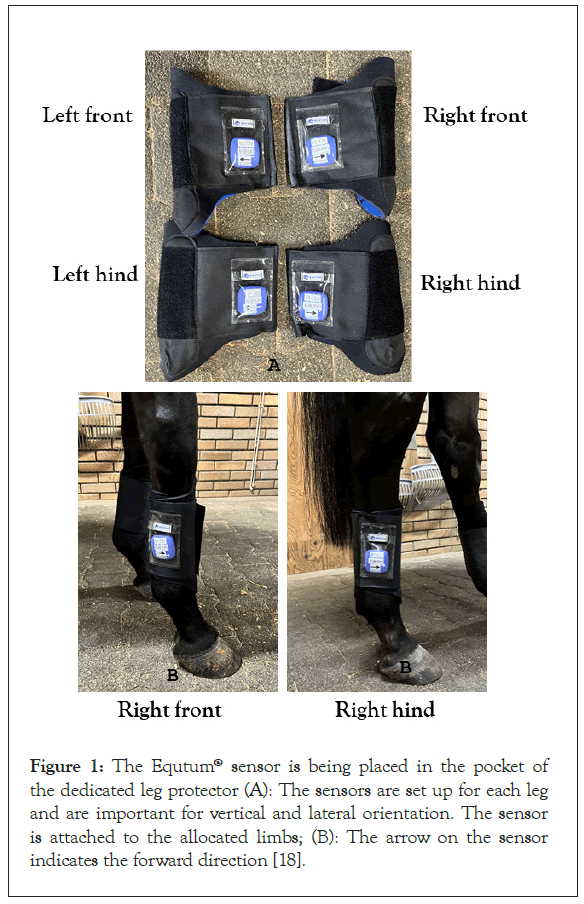
Figure 1: The Equtum® sensor is being placed in the pocket of the dedicated leg protector (A): The sensors are set up for each leg and are important for vertical and lateral orientation. The sensor is attached to the allocated limbs; (B): The arrow on the sensor indicates the forward direction [18].
The heart rate monitor (Polar Equine trotters, Polar, Japan) is attached to the front of the abdominal belt (Figure 2A). The elastic, soft, optimized belt has a button to attach the heart rate sensor and a plastic buckle for easy attachment and removal. At this time, ultrasound gel is applied to maintain contact between the monitor portion of the belt and the horse (Figure 2B). When the dedicated Equtum® app on the smartphone that receives information from the sensors is launched, communication with the sensors begins immediately, and when each sensor is recognized, the "Start measuring" indicator is ready to be tapped (Figure 3).
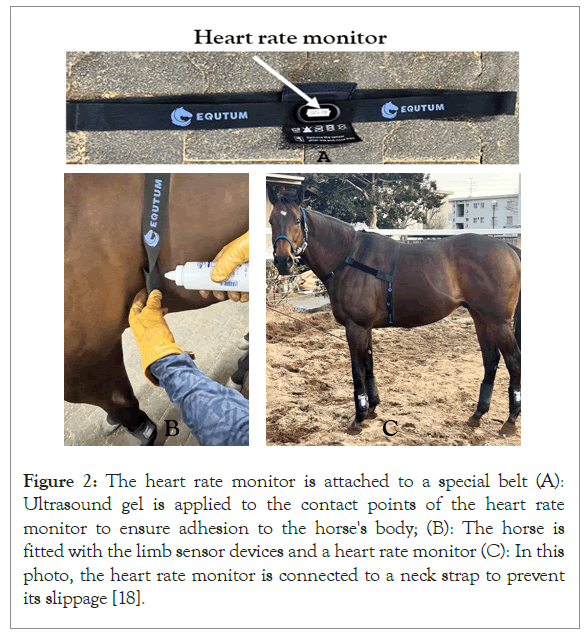
Figure 2: The heart rate monitor is attached to a special belt (A): Ultrasound gel is applied to the contact points of the heart rate monitor to ensure adhesion to the horse's body; (B): The horse is fitted with the limb sensor devices and a heart rate monitor (C): In this photo, the heart rate monitor is connected to a neck strap to prevent its slippage [18].
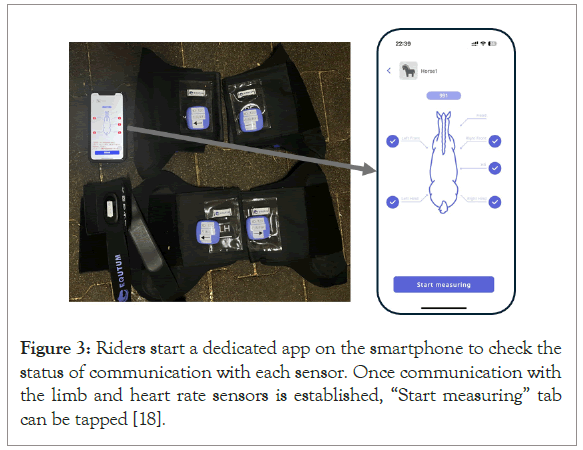
Figure 3: Riders start a dedicated app on the smartphone to check the status of communication with each sensor. Once communication with the limb and heart rate sensors is established, “Start measuring” tab can be tapped [18].
After communication with each sensor is established, the smartphone is placed in the pocket of the special saddle cloth and the horse is subjected to the training (Figure 4). When a horse equipped with the sensors trains on the training course, data such as stride, pitch, impact when the leg touches the ground, ratio of legs swinging in space (Swing Time Ratio, STR), heart rate, etc., based on the distance travelled, speed, leg angles such as left/right or front/rear, and acceleration, as well as position information, are transferred to a server in the specialized cloud [18]. All data is stored on a dedicated server in the cloud. Only the senior trainers and related personnel with access rights can access and check these data in real time or after training using a registered terminal device. Each data is strictly protected, and only those who have been given access key can access the data (Figure 4).
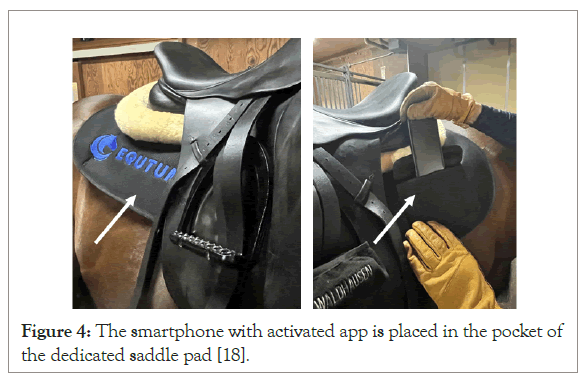
Figure 4: The smartphone with activated app is placed in the pocket of the dedicated saddle pad [18].
Test training and data collection
Horses used for test training were Thoroughbreds (2 geldings and 2 mares, ages 4-12 years) retrained as retired racehorses and competition horses (2 geldings, KWPN 22 years and Westphalia 22 years). The horses are kept in good health by veterinarians, who ensure that they are free of injury, disease, pain, and lameness. After attaching sensors and tablet terminals to the horses, the test training consisting of walk, trot, canter, and gallop for an arbitrary length of time was performed to check communication and data acquisition status. The data acquired from the sensors and the wearable tablet were analysed a dedicated terminal tablet device. These test trainings were conducted in accordance with the guidelines for animal experiments at Tokyo University of Agriculture and Technology and were approved by the university's animal experiment committee (Approval numbers R03-53, R04-86, R05-101, and R06-25).
Waveforms of four different gait patterns of horses
Attaching the sensors on horses was easy. Horses did not seem to be particularly concerned about the sensor, that were able to perform training exercises while wearing it without any hindrance. The communication with the tablet terminal was good, and various data could be acquired without any problems. Figure 5, shows what each waveform measured by the gyro sensors on the limbs indicates. The waveform of the gait is recorded in the following order: Stance, break over, swing, and impact. The differences in waveforms depending on the horse's gait acquired by the sensor are shown in (Figure 6). At walk, the left and right forelimbs alternately repeat a waveform with a large amplitude, while those of the hindlimbs are smaller. At trot, the waveforms with larger amplitudes are repeated for a shorter period of time than in walking. At canter, peak waveforms are observed not only in the forelimbs but also in the hindlimbs, and the repetition rate of the waveforms increases. At gallop, a waveform with a large amplitude is repeated, that is clearly different from the previous three gait patterns (Figures 5 and 6).
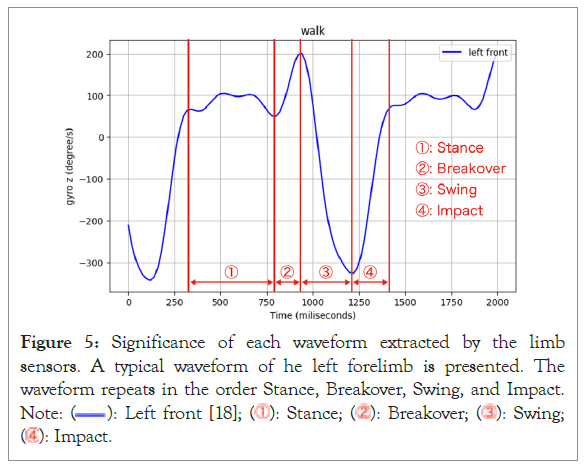
Figure 5: Significance of each waveform extracted by the limb sensors. A typical waveform of he left forelimb is presented. The waveform repeats in the order Stance, Breakover, Swing, and Impact.  Left front [18];
Left front [18]; 

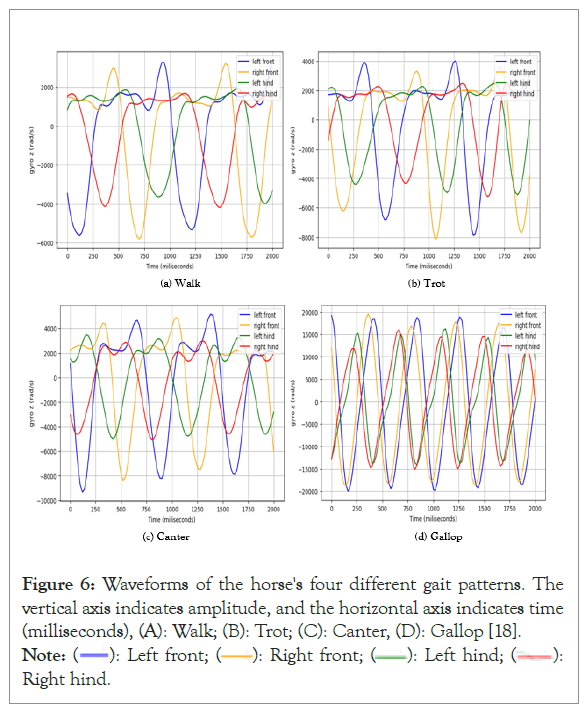
Figure 6: Waveforms of the horse's four different gait patterns. The
vertical axis indicates amplitude, and the horizontal axis indicates time
(milliseconds), (A): Walk; (B): Trot; (C): Canter, (D): Gallop [18].  Right hind.
Right hind.
Data acquisition during test training
Figure 7, shows the data acquisition screen during test training on the dedicated terminal tablet. Along with the positional information, data such as distance traveled, speed, acceleration, and heart rate at that time are acquired and drawn as a line graph on the training analysis screen (Figure 7A). On the gait analysis screen, the stride, pitch, impact of the leg on the ground, and the ratio of the leg floating in space (Swing Time Ratio, STR) are calculated and displayed (Figure 7B), which are calculated from the angle and acceleration of the leg on the left, right or front and back. In particular, the angles of limb step and kick-up are measured and their ratios are analyzed, allowing the trainer to review the data at each time point (Figure 7B). The angles of limb step-in and kick-up are analyzed as shown in Figure 7C, using the straight standing position as the reference (0o). Average degree of the step-in and kick-up angles of each limb are shown on the screen (Figures 7A -7C).
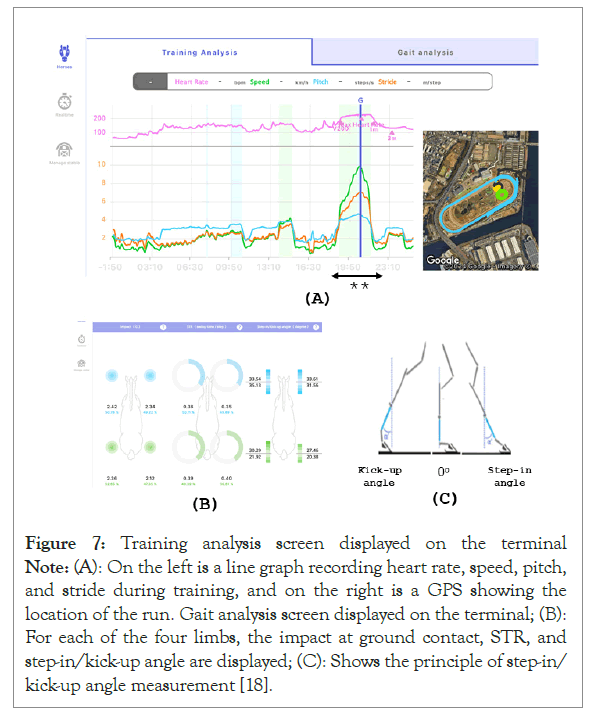
Figure 7: Training analysis screen displayed on the terminal. Note: (A): On the left is a line graph recording heart rate, speed, pitch, and stride during training, and on the right is a GPS showing the location of the run. Gait analysis screen displayed on the terminal; (B): For each of the four limbs, the impact at ground contact, STR, and step-in/kick-up angle are displayed; (C): Shows the principle of step-in/ kick-up angle measurement [18].
Figure 8, shows the waveform data for the time indicated by the arrow in Figure 7A, and the gait patterns and lead forelimbs were extracted. The time course of each gait on the graph is as follows: From start to 35 seconds is trot (a), from 36 to 55 seconds is canter in the left lead (b), from 56 to 148 seconds is gallop in the left lead (c), from 149 to 175 seconds is gallop in the right lead (d), from 176 to 219 seconds is gallop in the left lead (e), then canter in the left lead (f). In the data at this time, speed was maximal in the right lead gallop, and at the same time the stride was increased. The highest Heart Rate (HRmax) and the speed at the Ventricular High-Rate (VHRmax) was recorded at 175 seconds in the graph. The timing for the heart rate to reach 200 beats/min (V200) was 67 seconds. The pitch tended to increase in advance of the speed and reached at its highest value when the max speed was recorded. The heart rate rises immediately upon entering the gallop, remains almost flat, and then quickly declines as the speed is reduced to canter (Figure 8).
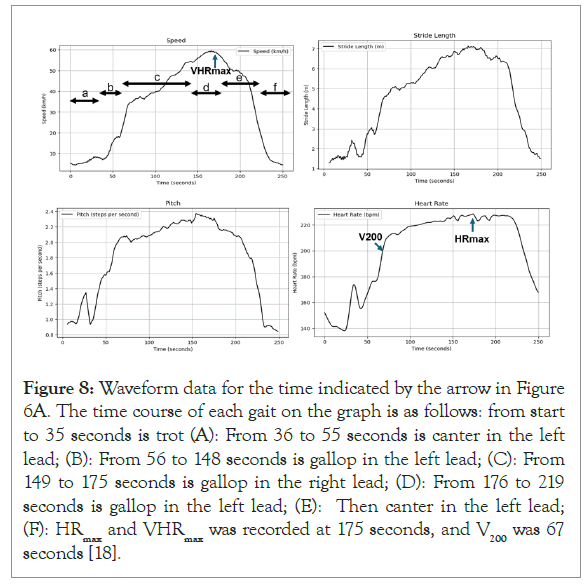
Figure 8: Waveform data for the time indicated by the arrow in Figure 6A. The time course of each gait on the graph is as follows: from start to 35 seconds is trot (A): From 36 to 55 seconds is canter in the left lead; (B): From 56 to 148 seconds is gallop in the left lead; (C): From 149 to 175 seconds is gallop in the right lead; (D): From 176 to 219 seconds is gallop in the left lead; (E): Then canter in the left lead; (F): HRmax and VHRmax was recorded at 175 seconds, and V200 was 67 seconds [18].
Equtum® analyzed the gait patterns, lead leg, ground impact, and STR during training, as well as step-in and kick-up angles of each limb. Heart rate, speed, stride length, and pitch were also recorded over time. The heart rate of a racehorse at rest is about 30 to 40 beats/min, and it has been observed that horses with high racing ability have a low heart rate at rest [19]. However, no large-scale analysis has been conducted. On the other hand, when a racehorse begins to run, its heart rate gradually increases, but once it exceeds 16 meters per second, generally its heart rate does not increase any further. The heart rate at this point is called the maximum heart rate (HRmax). HRmax varies greatly among individuals and is known to decrease with age [20,21]. When a horse is exercised at various speeds, the speed at which the maximum heart rate is recorded is called VHRmax [20,21]. VHRmax has been reported to correlate with maximal oxygen uptake, which increases with training, and is considered to be an excellent index for evaluating physical fitness of each horse [19]. In addition, the index that indicates the running speed when the heart rate reaches 200 beats/min is called V200 [20,21]. Conversely, the time point when the heart rate returns to 100 beats/min (THR100) indicates the resiliency of the heart and is an indicator of the horse's cardiopulmonary capacity. Studies have been conducted on the relationship between horse training and cardiopulmonary capacity using these indices, but no device has been developed that can simultaneously measure and analyze the exercise state of the limbs and the horse's balance, as well as heart rate. Using Equtum®, it is clear that HRmax, VHRmax, V200, and THR100 can be easily confirmed on the screen and comprehensively evaluated along with condition of each limb.
Various measurement devices have been developed to analyze the heart rate and speed of racehorses and competition horses during training [22-24]. Most of the system uses GPS to measure both speed and heart rate of the horse at the same time. Some of these measuring devices are attached on the girth and transmit speed and heart rate data to a dedicated terminal. Riders and trainers receive data feedback for short- and long-term analysis of the horse's speed and balance during training, as well as changes in the horse's movement due to riders. Data is visualized using a dedicated app installed on a tablet device. In contrast, Equtum® is a system that measures positional information, speed, and heart rate, along with various information from each limb, for a more comprehensive evaluation of the horse's movement. Moreover, on the gait analysis screen, data of the impact, STR, and step-in/kick-up angles of each limb help trainer to know the horse's left/right or front/rear balance, and dominant lead legs. This equipment can be used not only for training, but also for veterinary purposes such as rehabilitating injured horses and determining the effectiveness of treatment.
In horse training, particularly in training of racehorses, trainer experience has been highly important, but it has been difficult to quantify and visualize. Equtum®, the IoT device exclusively used in horse training, is a device that enables decision-making based on numerical values by providing real-time data. Currently there are various devises on the market that will evaluate these parameters individually but not together. The major advantage of the device described here over others on the market is the comprehensive evaluation of gait along with cardiopulmonary parameters and speed. In addition, by inferring the distance aptitude and fatigue level of the relevant horse based on past training and race results, more accurate evaluations of training time, intensity, and training intervals can be made. Large-scale data extraction using racehorses has already been conducted in Japan, and the results will be presented in the future, keeping individual information confidential. Furthermore, in cooperation with veterinarians, it will be effective in predicting and early detection of pain and/ or injuries of horses. We believe that the use of this system will contribute to a future in which all racehorses and competition horses can safely perform at their best.
In collaboration of veterinarians and IT engineers, a device was developed to visualize the gait and balance of racehorses and competition horses during training. Until now, the condition of horses in training has been visually monitored by trainers and sensed by riders, but the development of a sensitive analysis system has been advocated for the early detection of injuries and illnesses of horses, as well as for safety of riders. By attaching GPS and a heart rate monitor to the horse, speed and heart rate data can be determined. In this joint research and development, we have succeeded in developing a device that analyzes and records the horse's gait, stride, pitch, front, and impact at ground contact for each of the four limbs. Furthermore, by integrating data from the limb sensors with heart rate data on a dedicated app, the horse's condition during riding can be more delicately assessed, and V200 and THR100 can be identified immediately. The device is expected to enable early detection of injuries and illnesses from gait and heart rate irregularities of athlete horses during training for races and competitions, ultimately extending the horses' competitive life span.
We would like to appreciate Ms. Masako Sakuma, Ms. Ayano Hagiwara, and Ms. Rino Yanaida (Tokyo University of Agriculture and Technology) for their excellent horse care and training. We are grateful for Drs Hiroaki Sato, Shuntaro Urayama, Masanori Muranaka (Japan Racing Association, Tokyo, Japan) for their valuable advice and supports.
Conceptualization, A.T. and H.M.; methodology, H.O and T.T; validation, A.T., R.M, and H.M; formal analysis, A.T., R.M, and H.M; investigation, A.T., R.M, and H.M; resources, M.O., H.O., and T.T; writing-original draft preparation, A.T.; writing-review and editing, A.T., R.M, H.O., T.T., M.O., and H.M,; project administration, A.T. and H.M. All authors have read and agreed to the published version of the manuscript.
This work was supported by a grant for race-horse production and development 2021, 2022, and 2023 provided by the Japan Racing Horse Association.
The experimental protocol was approved by the standards specified in the guidelines provided by the Animal Care and Use Committee of the Tokyo University of Agriculture and Technology as well as those in the Science Council of Japan’s guidelines for the use of experimental animals (approval numbers R03-53, R04-86, R05-101, and R06-25, April 1st in 2012, 2022, 2023, and 2024).
This work was performed in collaboration with Tokyo University of Agriculture and Technology and ABEL Inc. Both Hideki Oshima and Tomoki Tanezaki are employees of ABEL Inc.
[Crossref] [Google Scholar] [PubMed]
[Crossref] [Google Scholar] [PubMed]
[Crossref] [Google Scholar] [PubMed]
[Crossref] [Google Scholar] [PubMed]
[Crossref] [Google Scholar] [PubMed]
[Crossref] [Google Scholar] [PubMed]
[Crossref] [Google Scholar] [PubMed]
[Crossref] [Google Scholar] [PubMed]
[Crossref] [Google Scholar] [PubMed]
[Crossref] [Google Scholar] [PubMed]
[Crossref] [Google Scholar] [PubMed]
[Crossref] [Google Scholar] [PubMed]
[Crossref] [Google Scholar] [PubMed]
[Crossref] [Google Scholar] [PubMed]
[Crossref] [Google Scholar] [PubMed]
[Crossref] [Google Scholar] [PubMed]
Citation: Tanaka A, Oshima H, Tanezaki T, Muko R, Oikawa M, Matsuda H (2024) Development of a New IoT Device to Acquire and Analyze Gait Information of Horses in Training. Poult Fish Wild Sci. 12:277.
Received: 02-Jul-2024, Manuscript No. PFW-24-32589; Editor assigned: 05-Jul-2024, Pre QC No. PFW-24-32589 (PQ); Reviewed: 22-Jul-2024, QC No. PFW-24-32589; Revised: 29-Jul-2024, Manuscript No. PFW-24-32589 (R); Published: 05-Aug-2024 , DOI: 10.35248/2375-446X.24.12.277
Copyright: © 2024 Tanaka A, et al. This is an open-access article distributed under the terms of the Creative Commons Attribution License, which permits unrestricted use, distribution, and reproduction in any medium, provided the original author and source are credited.